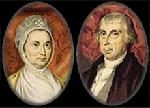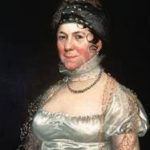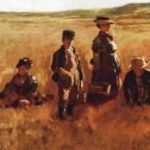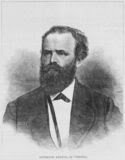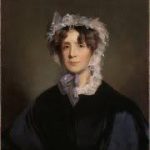James Madison’s First Love
Image: James Madison
Born in 1751, James Madison was the oldest among the eleven children of James Madison Sr., the wealthiest man in Orange County, Virginia. Even as a child, Madison had been unusually studious. As a young boy, he left his father’s plantation to attend an advanced school in a neighboring county. After five years studying astronomy, French, logic, mathematics and philosophy, he returned to his family’s plantation, Montpelier, to be tutored for two more years by a local minister.
James Madison
By Charles Willson Peale, 1783
Oval portrait miniature given to Kitty Floyd as a pin in a velvet-lined container.
From the Library of Congress Rare Book and Special Collections Division.
In 1769, Madison arrived at the College of New Jersey (now Princeton University). Under its new president John Witherspoon, students studied the moral philosophy of Frances Hutcheson, Thomas Reid, and Lord Kames, and the political philosophy of Adam Smith and David Hume. Madison zipped through the College’s undergraduate curriculum in two years rather than the usual three or four, and then stayed on for another year to study ethics and Hebrew.
When Madison returned to his home in Virginia in the fall of 1772, he was only twenty-one years old, but the prospect of becoming a farmer in the remote Virginia Piedmont depressed him. However, as America’s growing conflict with England began to encroach on the lives of people in Virginia’s backcountry, Madison was drawn into revolutionary politics.
In December 1774, he was elected to the Orange County Committee of Safety, the local agency created to mobilize the county’s residents against the British. In the spring 1776 he was sent to the Virginia Provincial Convention, which on May 15 instructed its delegates to the Continental Congress to propose a declaration of independence.
Just a few years out of college, Madison was content to allow more established Virginia politicians such as Edmund Pendleton, George Mason and Patrick Henry dominate the proceedings. However, Virginia’s political elders quickly recognized his intelligence, judgment and diligence, and sent him to the Continental Congress; at age twenty-eight (1778), he was the youngest delegate.
The Constitutional Convention
James Madison arrived in Philadelphia from New York City on May 3, 1787, eleven days before the Constitutional Convention was due to begin. He had hoped that other members of the Virginia delegation would follow suit. Writing to Virginia’s Governor Edmund Randolph the month before, Madison urged him to arrive at least a week before the Convention’s start date in order that the Virginia delegates might take the lead in preparing “some materials for the work of the Convention.”
When Madison appeared at the State House on the morning of the fourteenth only a handful of delegates had turned up. Madison was by nature punctual and conscientious; moreover, he felt acutely the urgency of the need to get on with the business of constitutional reform. Thomas Jefferson was in Paris, and although he did not take part in the deliberations, he would serve as a sounding board for his friend Madison’s frustrations.
He blamed “the late bad weather” for the tardy arrival of the delegates, and to some extent that was true. Heavy rainstorms up and down the East Coast during the previous two weeks had turned the dirt roads into veritable rivers of mud. On a good day a delegate travelling to Philadelphia by horseback might cover fifty miles, and by carriage considerably less, but there were few good days that spring.
Madison would have to wait eleven more days, until May 25, for the Convention to get underway. He spent much of that time in his lodgings at Mary House’s boardinghouse a block from the Pennsylvania State House. He would be joined there during the summer of 1787 by five other delegates to the Convention – James McHenry of Maryland, John Dickinson and George Read of Delaware, Charles Pinckney of South Carolina and Edmund Randolph of Virginia.
Miss Kitty Floyd
Madison returned to Mrs. House’s with powerful and bittersweet memories. He had stayed there from March of 1780 until the fall of 1783 while serving his first term in the Continental Congress. During that winter and spring of 1783, the cerebral Madison fell in love with Catherine “Kitty” Floyd, the beautiful fifteen year old daughter of the Continental Congress delegate from New York, William Floyd, who also lived at the boardinghouse.
Thirty-two years old at the time, Madison was extraordinarily shy in social situations, particularly ones in which attractive women were involved. Standing only a few inches over five feet tall and prematurely balding, he frequently brushed the few remaining wisps of hair at the top of his head downward to hide his bald spot.
Chronically suffering from poor physical health, usually dressed in dark colors and awkward in any form of public speech, Madison came across as neither a commanding nor a self-confident figure. That lack of self-confidence may well have prevented him from risking rejection from a woman his own age, but Kitty Floyd’s girlish spontaneity emboldened his romantic instincts.
Thomas Jefferson had boarded at Mary House’s establishment in the winter of 1783 and had seen proof of the mutual attraction between Kitty Floyd and Madison. On his way back to Monticello in April of 1783, Jefferson wrote Madison a letter urging him to propose marriage. Madison replied with characteristic earnestness:
Your inference on that subject was not groundless. Before you left us I had sufficiently ascertained her sentiments. Since your departure, the affair has been pursued. Most preliminary arrangements, although definitive, will be postponed until the end of the year in Congress. At some period of the interval I shall probably make a visit to Virginia. The interest which your friendship takes on this occasion in my happiness is a pleasing proof that the dispositions which I feel are reciprocated.
Madison and Kitty exchanged miniature potraits of themselves by Philadelphia artist Charles Wilson Peale, and love was still in bloom when Floyd and his children left for New York on April 29, 1783, five days after Kitty turned sixteen. Madison accompanied his fiancee and her family on a two-day trip by carriage to Brunswick, New Jersey, there to say good-bye as the Floyds headed off to their Long Island home for the first time in seven years.
By late July Madison had an inkling that something was wrong, noting to Edmund Randolph that his return to Virginia would be delayed “by a disappointment in some circumstances.” On August 11, 1783, Madison broke the bad news in a letter to his friend Jefferson (written in a numerical code they had devised). Kitty had fallen in love with someone else – a nineteen year old medical student at the College of Philadelphia named William Clarkson. While away from them both at her country home, Kitty had decided that she loved William more than James, and later married Clarkson.
The trajectory of Madison’s romance was perhaps predictable. Madison was scholarly and introverted, described as “a good man and an able man,” but a man of “rather too much theory… He is also very timid and seems evidently to want manly firmness and energy of character.” Only in the eighteenth century, where intellect and character were at least as highly valued as wit and good looks, could a person like James Madison have achieved public prominence.
The brief but, for Madison, painful romance wounded him more than he cared to admit. So he avoided social encounters and spent hours relaying news from New York to his family and friends, and became a confirmed bachelor. Madison did not marry until September 15, 1794, when he wed an engaging young widow, 26-year-old Dolley Payne Todd.
In 1813, four years after James Madison entered the White House, Kitty’s husband died, leaving her a 46-year-old widow with three children. In 1817, her father wrote a will in which he accused her of squandering “considerable sums” of money he had given her, as well as a piece of land worth $7,000, and bequeathed her only $70 a year. Just before he died four years later, Floyd softened and gave Kitty a piece of land in Oneida County and an additional $1,000.
Kitty Floyd was living with a daughter in New York City when she died at age 65 in 1832. She was buried in Greenwood Cemetery in Brooklyn.
Madison never got over Kitty. When the fourth president of the United States was nearly 80 he came into possession of the two letters he had written about Kitty to Jefferson in 1783. Madison was so upset in rereading his own words that he violently inked out the references to his lost love.
James Madison died at Montpelier on June 28, 1836, at the age of 85.
SOURCES
James Madison Timeline 1751-1836
Richard R. Beeman: James Madison, The Scholar

